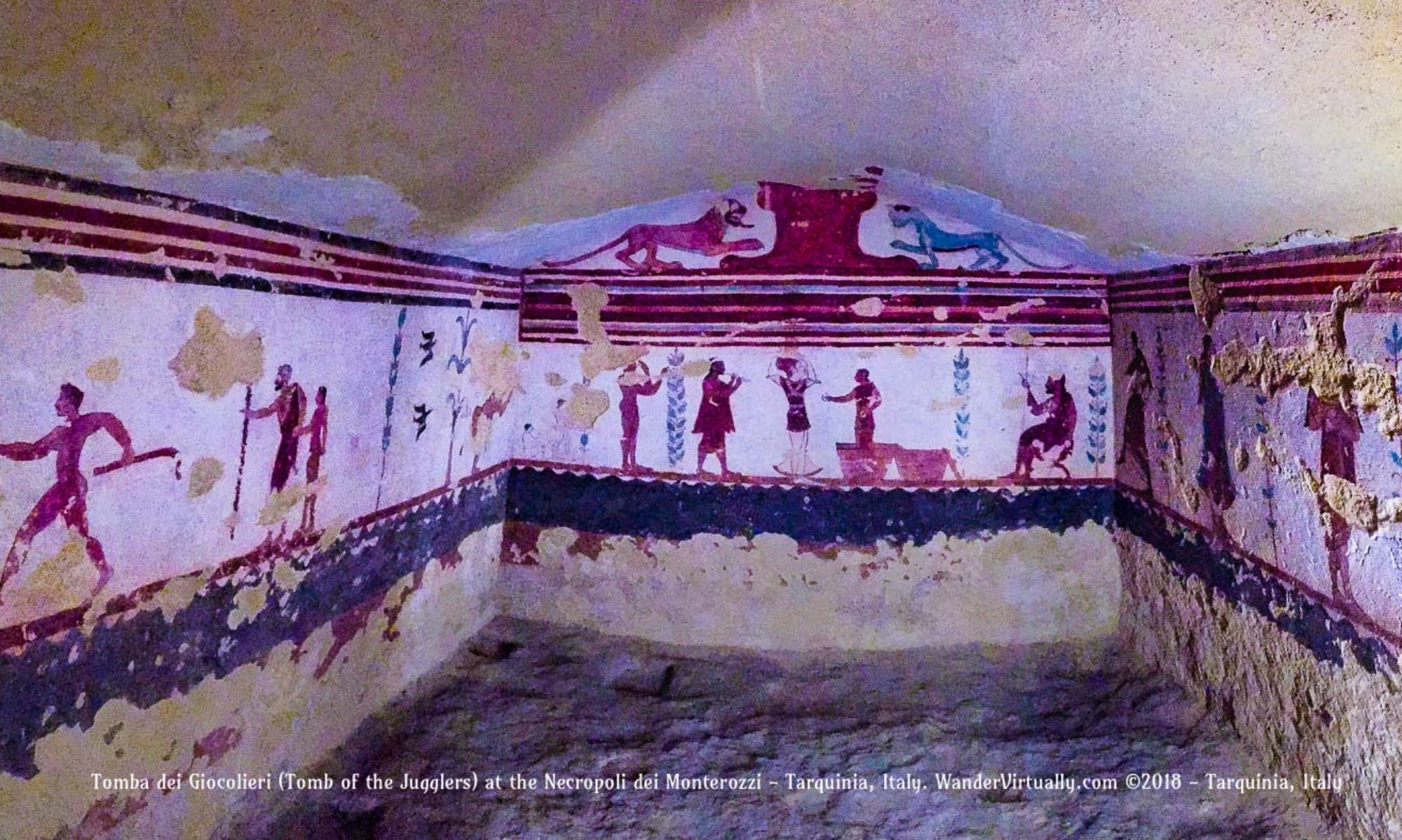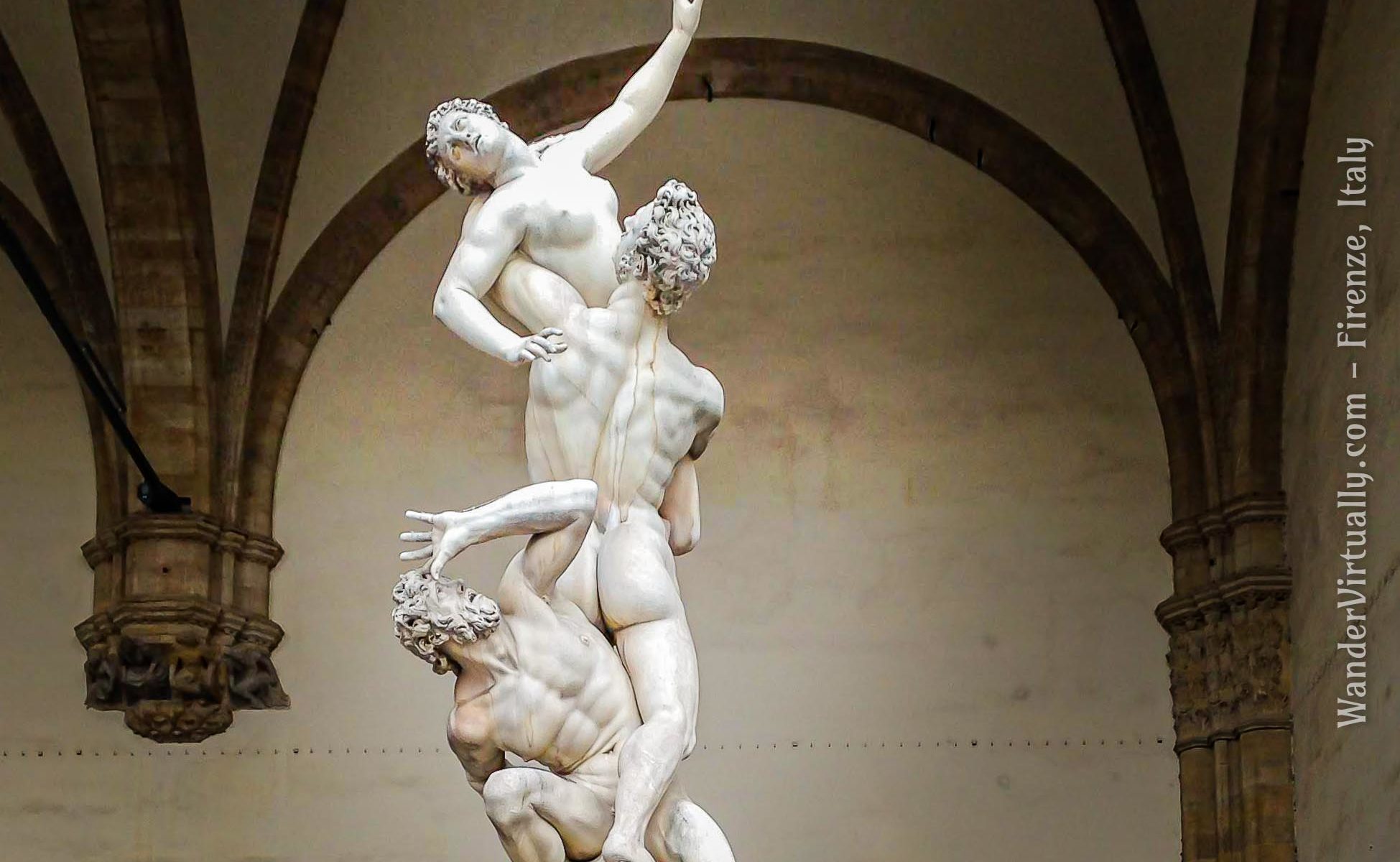The Rape of the Sabine Women was one of the most consequential episodes from Rome’s pseudo-historical foundation story. Two thousand three hundred years later, a sculptor of immense talent set the story on fire again through a sculpture that captured the drama, dynamism, and passions of the kidnapping event.
Featured photo: Giambologna’s Il Ratto delle Sabine at the Piazza della Signoria in Florence, depicts the legendary story about the kidnapping of Sabine women by the Romans.

This post has more than 3,000 words.
Average reading time: 17 minutes.
The Sculpture: A Renaissance Breakthrough
When you visit Florence, you’ll find yourself inevitably drawn towards the Piazza della Signoria, the town’s center. You’ll find some of the finest sculptures from the Renaissance in this piazza.
VIRTUAL SCENE (instructions to view this 360 Google StreetView photo)
You can interact with 360 photos and see all around!
Move/Rotate the photo: Use your mouse or fingers to drag and rotate the view around or upward-downward.
On tablets or desktops: The square icon on the upper right corner maximizes or minimizes the photo.
Magnify the view: To zoom in or out, use the + or – sign on the lower right corner.
One of them stands at the front of the Loggia dei Lanzi – an amazing work of art so full of action that it pulls you like a magnet to inspect what’s happening:
A struggling woman
desperately flailing her arms in the air,
the powerful young man
who had seized her, stepping over
the terrified old man
cowering helplessly on the ground.
Giambologna’s Artistic Genius
In the 16th century, the 2nd Grand Duke of Tuscany, Francesco I de’ Medici commissioned the sculptor, Giambologna, to create a sculpture from a huge block of marble. Giambologna (aka Jean de Boulogne or Giovanni da Bologna) took a few years to plan, practice, and produce the most awesome and compelling statue of the time: a 3-figure sculpture in high drama using only 1 block of marble.

When he unveiled the 13-foot marble sculpture at the piazza in 1582, people marvelled at how he had beautifully captured a dynamic moment. The sinuous upward movement and twisting action of the three individuals and their emotions were frozen in time. There was not just one point of view. As you walk around the sculpture, you realize the complexity of the composition.
No one had ever carved a group of three colossal figures from a single block of marble, since antiquity. Not to mention a creation with so much energy emanating from it. Giambologna’s work was a celebrated breakthrough that influenced art for centuries.
Name That Sculpture
There’s a story noted in the L’Accademia Gallery about how Giambologna produced the sculpture without a specific story in mind.
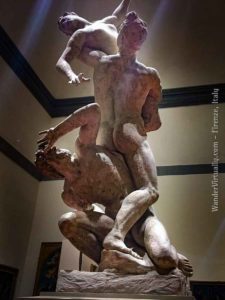
When he created the sculpture, the artist was more concerned with the technicality of carving 3 animated figures from a single piece of marble than with telling a story.
Vincenzo Borghini – a Benedictine scholar and artistic advisor to the Medici – was supposed to have suggested the title “il ratto delle sabine” (the rape of the sabine women) after seeing the statue. I’m a little skeptical about this claim, since I found out that Borghini had died in 1580 and would not have seen the completed work in 1582.
Whatever the case, the sculpture was belatedly called il Ratto delle Sabine – a fitting and appropriate title for the masterpiece.
In order to support this storyline, Giambologna created a bronze relief carving for the base of the main sculpture. It depicted a scene with Roman soldiers seizing and carrying off women.
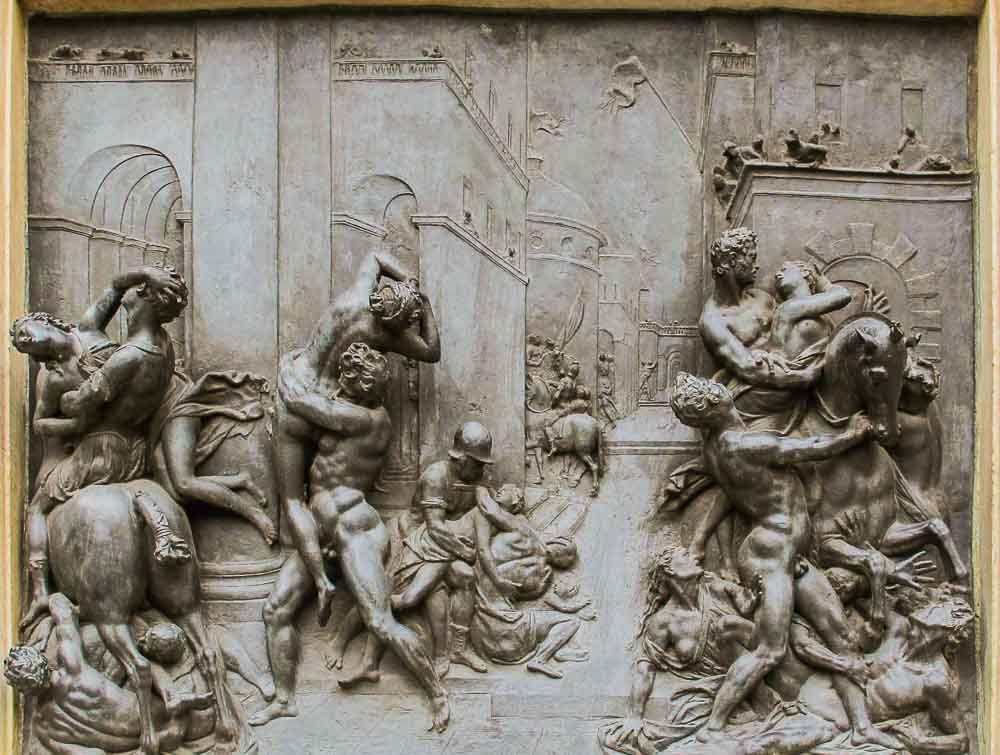
Scholars today try to clarify that the “ratto” or “rape” in the title should not be interpreted in the modern context of sexual violence. The Roman and Greek historians who wrote the story intended the Latin word raptio or ad rapiendas to mean “to seize and carry off”, “to abduct”, “to kidnap”.
In the story, Romulus instructs his soldiers to seize and carry off the maidens without sexually violating them. Therefore, given the modern connotation of “rape”, recent scholarly articles on the sculpture refer to it in English as The Abduction of the Sabine Women, instead of The Rape of the Sabine Women.
Giambologna’s Gems at the Piazza della Signoria
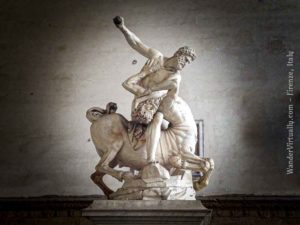
Art historians tell us that Giambologna was only second to Michelangelo in fame and accomplishment when it comes to Renaissance sculpture. Nevertheless, Giambologna delivered on a sculptural problem that even the divine Michelangelo could not solve.
His fame never waned during his lifetime and he went on to create more colossal (as well as miniature) sculptures for the rest of his life.
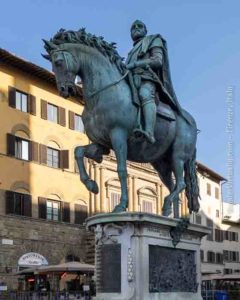
Giambologna has no less than three gigantic sculptures at the Piazza della Signoria.
In addition to the Ratto delle Sabine, his marble Hercules and the Centaur (which I wrote about here), and the bronze equestrian statue of Cosimo I, first Grand Duke of Tuscany are installed in the piazza.
If you are visiting Florence, you are very fortunate indeed that these works of art stand at a publicly accessible place – and can be appreciated for free.

A Roman Story: The Abduction of the Sabine Women
The Roman and Greek writers who wrote about the abduction of the Sabine women lived several hundred years after the legendary event. They did not always have their “facts” aligned.
For example, some say the event happened several months after the founding of Rome in 753 BCE. Others say it happened 4 years after the founding (749 BCE) since it would have taken time to organize and build Rome into some semblance of a small city with a small army.
Another point of inconsistency is, how many women were kidnapped: some say 30; others say 527; and still, others say 683.
Discrepancies aside, I will present a dramatized fusion of the accounts by 3 ancient historians in this version of the story – Dionysius of Halicarnassus (DH), Livy, and Plutarch.
The abduction and its subsequent events is a story of high drama, and presents Romulus, the founder and the first king of Rome, as a clever, compassionate and magnanimous leader.
With this historical marker, Romulus planted the first seed that enlarged Rome’s territory and multiplied its population – an innovative expansionist policy during ancient times.
August 18, 749 BCE – A Festival at the Circus Maximus
On a dais along the eastern side of the Circus Maximus, Romulus sat on his curule chair, his long purple cloak on his lap. In a few minutes, the race will start. Twelve Etruscan horses stood at the northwestern end of the tracks. The bareback horses were alert and expectant. Their riders were tense, their colorful capes clinging to their backs.
The first king of Rome surveyed the multitude of spectators crowding the long, grassy banks of the hippodrome. They’ve never heard of the Consualia festival before, much less, one dedicated to Neptune. But who could resist a festival, where food, wine, and entertainment flowed for free?
Hundreds of families from the neighboring towns of Caenina, Antemnae, and Crustumerium were here.
Sabine families from Cures and the other towns of Sabinium comprised the majority of the visitors.
Men came with their wives, sons, and daughters. They were all his guests.
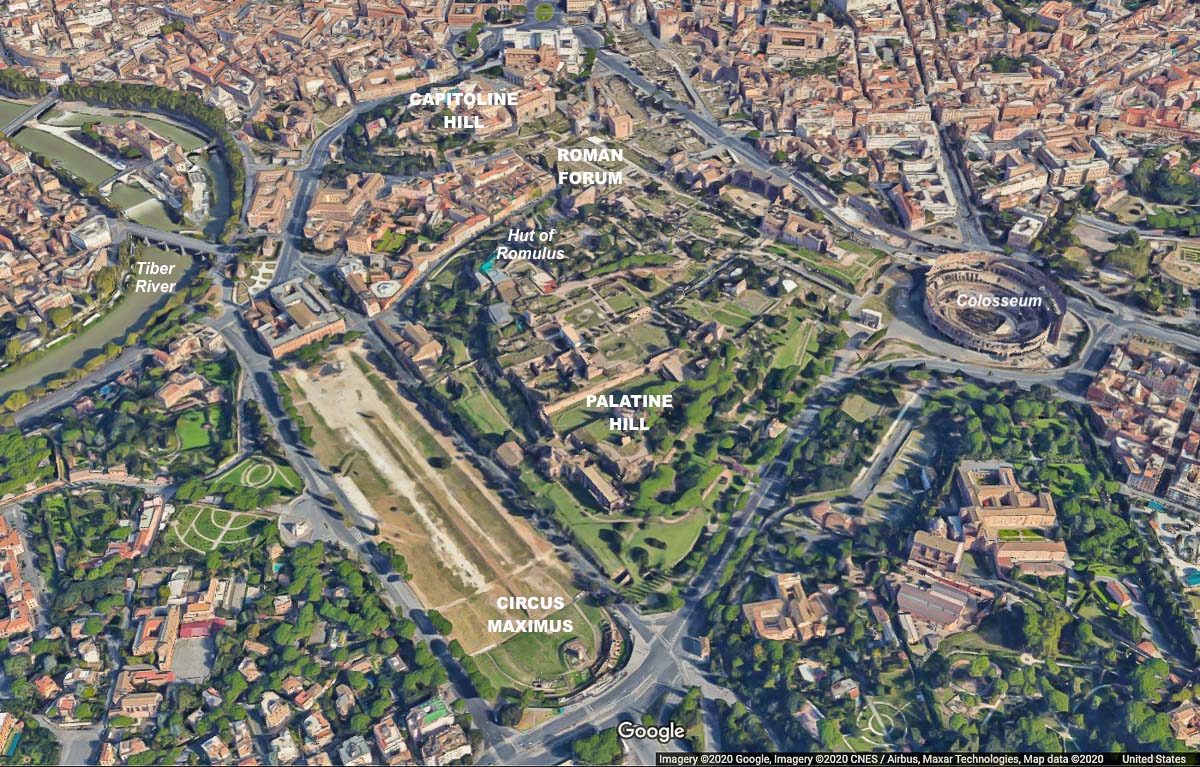
Rome’s Neighbors Join the Party
Caeninenses, Antemnates, Crustumerians, and Sabines.
They came to observe this morning’s prayers and the sacrifice to Neptune Equester – in whose honor the Romans dedicated today’s Consualia festival.
They came to join the feast of the sacrificial meats, the fruits, and the wine that the Romans offered.
They came for the games, the horse race and the prizes.
Most of all, they came to satisfy their curiosity about their neighbor, Rome, the new kid on the block. They wanted to see what Rome looked like four years after they occupied the Palatine Hill.
They wanted to see what the Romans were really made of – men whose overtures they recently rejected, out of fear and ignorance.
A few months ago, they received Romulus’ request for their young women to marry the Roman men and to form an alliance. But they were all suspicious of the new city and declined Romulus’ proposal.
They thought Rome was a lowly town built by aggressive and ambitious Alban shepherds. They heard that the city welcomed a riffraff of immigrants, refugees, and social rejects from neighboring cities – and made them Roman citizens.
Not exactly the kind of men they would like their daughters to marry…
The Young Romans
Romulus shifted his gaze from the guests. He watched as his men – robust young Roman soldiers – positioned themselves in groups among the enthusiastic crowd whose excitement was growing by the minute. The soldiers were looking at him, waiting for his signal.
It was almost time.
Over the last few years, he recruited these young men to join the small Alban tribe that his grandfather, Numitor, ceded to him and his twin brother Remus. But he had lost his twin brother, Remus, and half of the Alban tribe when they battled over property boundaries. A sad and unfortunate turn of events, but Romulus would not dwell on it.
He formed the remaining Albans and the new recruits into a new tribe, and he called them Romans. Together, they colonized the area of the Palatine and Capitoline Hills and founded the city of Rome. That was in April 753 BCE.
They built their homes on the hills and raised a wall along the perimeter. He organized them into social groups and divided the land among them. They selected a group of elite men whose advice he would seek from time to time. He established laws and the practice of religion. He trained them on how to be soldiers and farmers at the same time. It has been 4 years since the founding, and they are proud of their achievements.
But Romulus knew that this colony of 3000 men would not survive beyond this generation. They had too few women and children. They needed to do something fast.
If the neighboring towns would not allow their women to marry Roman citizens, he thought, then he will do it the old-fashioned way.
Raptio!
And they’re off! The horses and their riders pushed past the starting line, stirring clouds of dust behind them. The crowd went wild as they cheered for their favorites.
As some horses broke away, the spectators went into a frenzy urging the galloping beasts and their riders to go faster. Quickly, the swift horses and their riders turned at the racetrack’s southeastern turning post.
Romulus rose from his seat, folding his long purple cloak over his arm. Then, as the horses went past him, he threw the cloak over his shoulders.
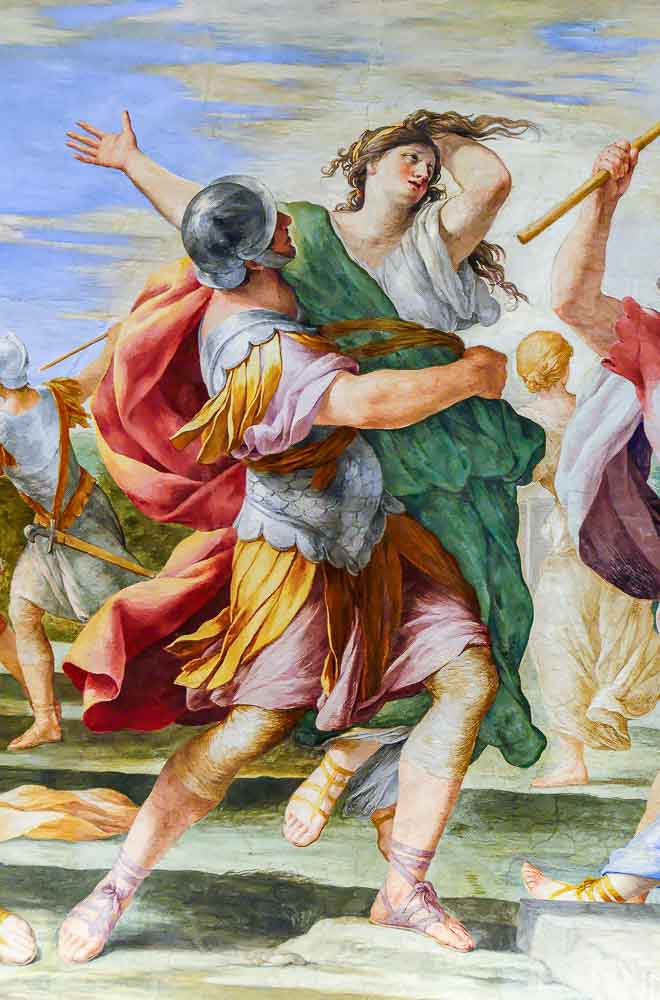
RAPTIO!
On this signal, the young Roman soldiers moved quickly to seize the young maidens they had targeted in the crowd.
The women screamed, but the sound was lost in the increasing crescendo of shouts and jubilation as one after the other, the horses sped towards the end of the racetracks.
Slowly, excitement turned into confusion, then desperation and fear, as the spectators realized what was happening.
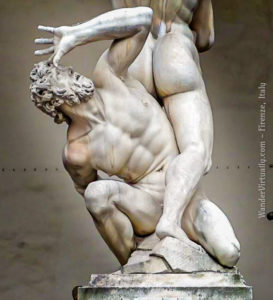
The Romans carried off the struggling and screaming damsels over their shoulders and dashed from the Circus Maximus towards the gates of the Palatine Hill. The other Roman soldiers foiled the fathers, brothers, and mothers who tried to run after them.
Romulus Appeals to the Kidnapped Women
Inside the walls of the Palatine, the Romans assembled the kidnapped women and tried to pacify them. Romulus had instructed the men not to sexually violate the maidens.
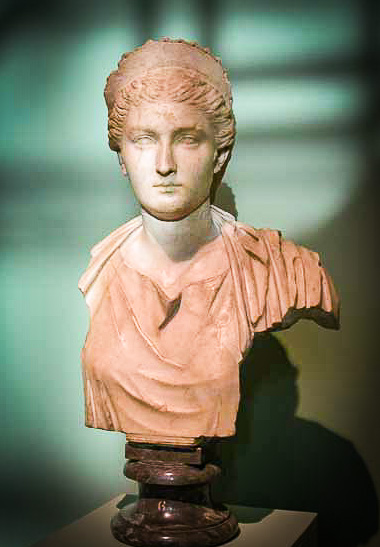
In this mass abduction, the Romans kidnapped 683 women. Most of them were Sabine women, but there were also maidens from Caenina, Antemnae, and Crustumerium.
When the women’s energies were spent from screaming and crying, Romulus came and comforted them.
The charismatic leader explained that they were abducted because their parents refused to consider their intermarriage with the Romans. He said that marriage by abduction was a common and acceptable practice by the Greeks.
He pleaded with them to curb their anger and receive their future husbands. He promised that they would be more loving and considerate because,
“A sense of injury had often given place to affection, and they would find their husbands the kinder for this reason, that every man would earnestly endeavour not only to be a good husband, but also to console his wife for the home and parents she had lost.”
Livy (Ab Urbe Condita, 1.9.15)
Romulus then selected Roman men and married them to the maidens, according to their rites.

Did you know? Plutarch claimed that this event gave rise to the wedding tradition where the groom had to carry the bride into the threshold of their new home – because the bride would not willingly enter it otherwise.
Photos courtesy of Katelyn MacMillan on Unsplash. Ref. (b-10).
Rome at War with the Neighbors
The kidnapping at the Circus Maximus outraged the cities from where the maidens came. The Caeninenses, Antemnates, and Crustumerians pleaded with King Tatius, king of the Sabines, to lead them into war with the Romans.
But the Sabines dragged their feet with many meetings, deliberations, and negotiations with the Romans. Many months passed.
Unable to wait any longer, the Caeninenses decided to go to war on their own. The Romans soundly defeated them, after Romulus killed their King Acron in single combat.
Romulus celebrated this victory by holding the first Roman triumphal march into Rome. The army paraded back into Rome, prisoners in tow, led by Romulus who displayed his spoils – King Acron’s armor – and offered them to Jupiter.
After the Caeininenses, the Antemnates followed suit, with the same result.
The Crustumerians followed the Antemnates, but were no more fortunate in their encounter with the Romans.
Each time the Romans won, Romulus instructed them not to loot or plunder the town. Instead, he dispensed forgiveness in consideration of the women who were kidnapped to marry the Romans.
Romulus gave a speech to the kidnapped women:
“Your fathers and brothers and your entire cities deserve to suffer every severity for having preferred to our friendship a war that was neither necessary nor honourable. We, however, have resolved for many reasons to treat them with moderation; …And we believe that to you, whose behaviour towards your husbands has thus far been blameless, this will be no small honour and favour. We suffer this offence of theirs, therefore, to go unpunished and take from your fellow citizens neither their liberty nor their possessions nor any other advantages they enjoy; and both to those who desire to remain there and to those who wish to change their abode we grant full liberty to make their choice, not only without danger but without fear of repenting.
D. Halicarnassus (Roman Antiquities, 2.35.3)
He sent Romans to colonize a third of each city they conquered. Then he also allowed families from those cities to come and settle in Rome if they so wanted.
“…Depart, therefore, with good courage; and redouble your love and regard for your husbands, to whom your parents and brothers owe their preservation and your countries their liberty.”
D. H.
But the Sabines decided to take their turn to go to war. King Tatius finally led the Sabine tribe against the Romans.
Sabines – being descendants of refugees from the warrior state of Sparta (if we believe DH and Plutarch) – were fierce fighters. And so, they engaged in a protracted and more ferocious battle between equals.
The Intervention of the Sabine Women
After several brutal encounters, the two armies paused from fighting to take stock of their losses. While contemplating drastic actions, they were surprised by the sudden appearance in their midst, of the kidnapped Sabine women.
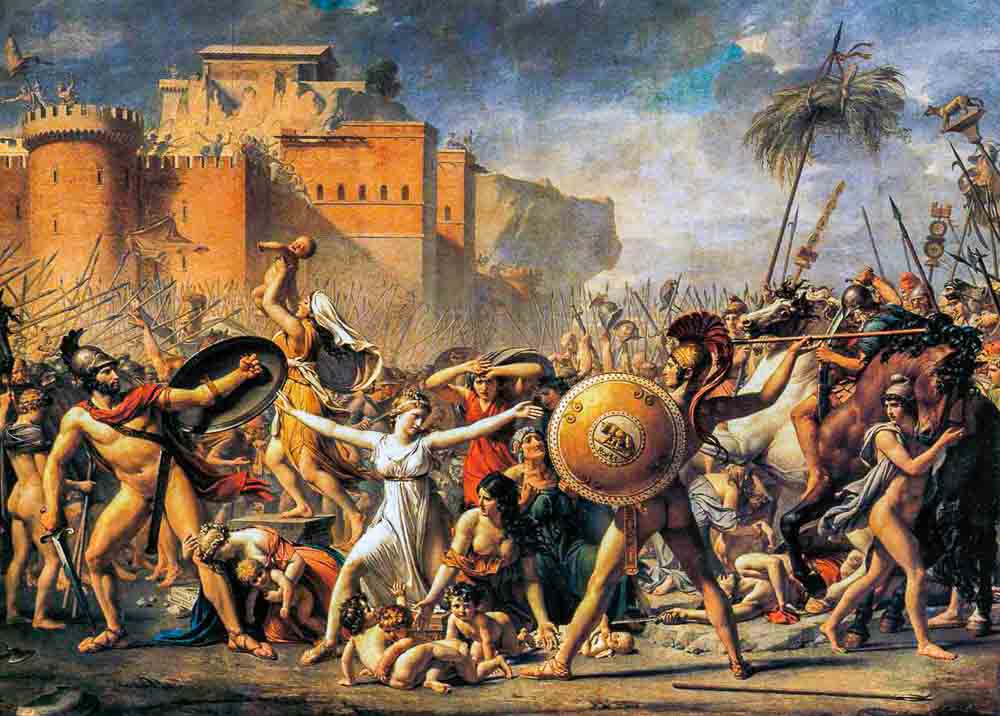
The Sabine women – having spent a significant time with their Roman husbands – had become domesticated and devoted to their spouses. With their toddlers and babies in tow, they pleaded with their fathers, brothers, and husbands to stop fighting:
“…We were violently and lawlessly ravished away by those to whom we now belong, but though thus ravished, we were neglected by our brothers and fathers and kinsmen until time had united us by the strongest ties with those whom we had most hated, and made us now fear for those who had treated us with violence and lawlessness, when they go to battle, and mourn for them when they are slain. For you did not come to avenge us upon our ravishers while we were still maidens, but now you would tear wives from their husbands and mothers from their children… Such is the love which we have here enjoyed… If, however, the war is on our behalf, carry us away with your sons-in‑law and their children, and so restore us to our fathers and kindred, but do not rob us of our children and husbands. Let us not, we beseech you, become prisoners of war again.”
Plutarch (Romulus, 19.3-5)
The Roman and Sabine men were touched by these entreaties. They called a truce and came to an agreement.
The Sabine women would remain with their Roman husbands, Sabines could live in Rome as they wished, and Rome would be ruled by the 2 kings, Romulus and Tatius.
Conclusion
Thus, Romulus began the unstoppable expansion of Rome. The expansionist policy he began lasted for a thousand years. As such, Rome grew from a hilltop town of shepherd shacks to an empire that surrounded the Mediterranean Sea.
But long after its physical expansion had ceased, Rome’s cultural and political influence went beyond its imperial borders. Thanks to its rediscovery during the Italian Renaissance, Roman influence extended well into the 21st century.

TL;DR Version
Here’s a 2-minute recap of this entire post. Skinny and stripped of the most interesting insights, if you didn’t read the full story.
- About the sculpture:
- Giambologna’s sculpture was a breakthrough. No one had done a colossal 3-figure statue from one block of marble since Roman times.
- Giambologna’s work didn’t have a title until it was finished. Then someone suggested, “Il Ratto delle Sabine”, or Rape of the Sabine Women. Rape here means abduction – not sexual violation.
- Giambologna has 2 other giant sculptures at the Piazza della Signoria. Don’t miss them.
- About the ancient Roman story:
- Romulus was worried he didn’t have enough women in his newly founded city of Rome in order to sustain it.
- He couldn’t persuade the neighboring cities to allow their daughters to marry the young Roman men.
- He then invited the neighboring cities to celebrate a new festival – called the Consualia – at the Circus Maximus.
- Hundreds of families came from the neighboring cities of Caenina, Antemnae, Crustumerium, and Sabinium.
- After the drinking and merry-making, they held a horse race where, at the height of the excitement, the young Romans seized and carried off hundreds of their neighbors’ daughters to their city on the Palatine Hill.
- Romulus persuaded the kidnapped women to marry his men. They eventually became fond of the men and bore them children.
- One after the other, the Caeninenses, Antemnates, and Crustumerians decided to go to war with Rome – and were all routed.
- Romulus was magnanimous because of the kidnapped women who married the Romans. The Romans did not loot or plunder the cities that were defeated. Instead, they colonized them and allowed the people to move freely and live either in Rome or in their own cities.
- The Sabines went to war last, and they were as fierce as the Romans. The Sabine women decided to intervene and stopped the men from fighting.
- Romulus and the Sabine king, Tatius, agreed to rule Rome together. The Sabines and Romans were allowed to live in any of the Roman and Sabine cities.
- From here on, Rome continuously expanded its borders and its population for a thousand years.

I derived this story based on the writings of Dionysius of Halicarnassus (Roman Antiquities), Livy (Ab Urbe Condita), and Plutarch (Parallel Lives: Romulus) – References (4, 5, 14). For a complete list of sources and resources used on this webpage, please see the References page.
Related Posts

Check my post on Hercules and the Centaur at the Piazza della Signoria

Check my post on Hercules and Cacus at the Piazza della Signoria

Get the story The Medici: Benefactors Of Your Sightseeing In Florence

Restaurants aren’t the only places where you can satisfy your gustatory longing for Italian cuisine. Markets are a great place for food finds – check out my post Alternative Dining at the Central Market or “Mercato Centrale”.
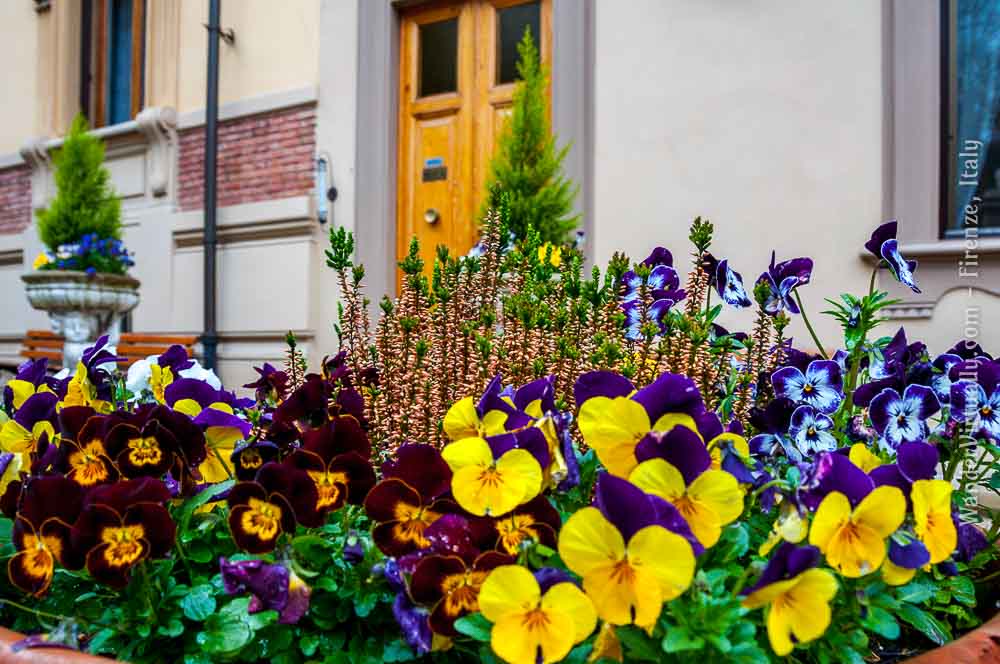
Where to stay in FLORENCE?Try Convents & Monasteries in Firenze, Italy

You don’t have to be Christian or religious to stay at an Italian convent or monastery. Find out if these safe, economical, and peaceful lodgings are right for you.
Visit the Italy page for more stories and travel tips …
BELLA ITALIA
Fascinating ancient stories.
Practical travel tales and tips.
